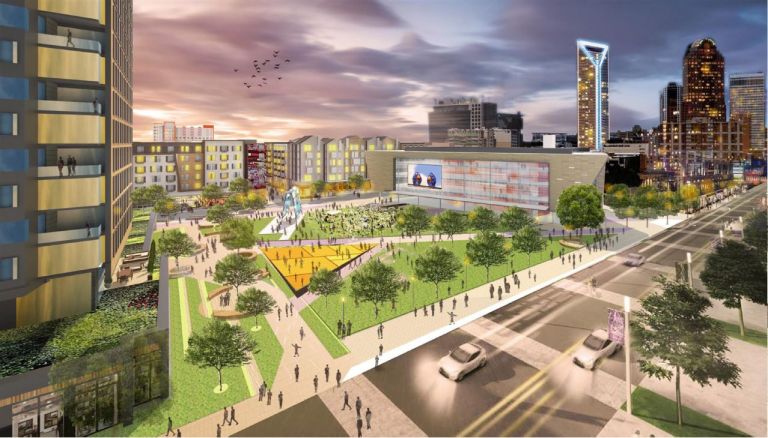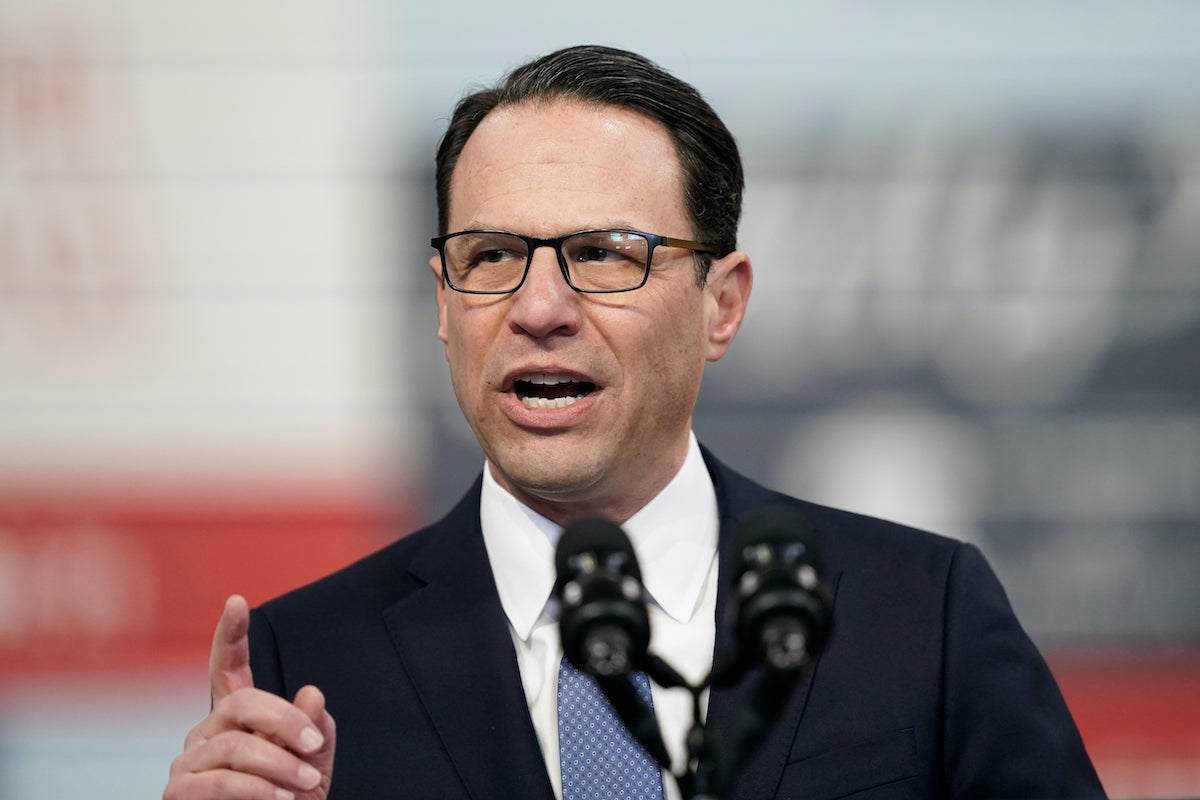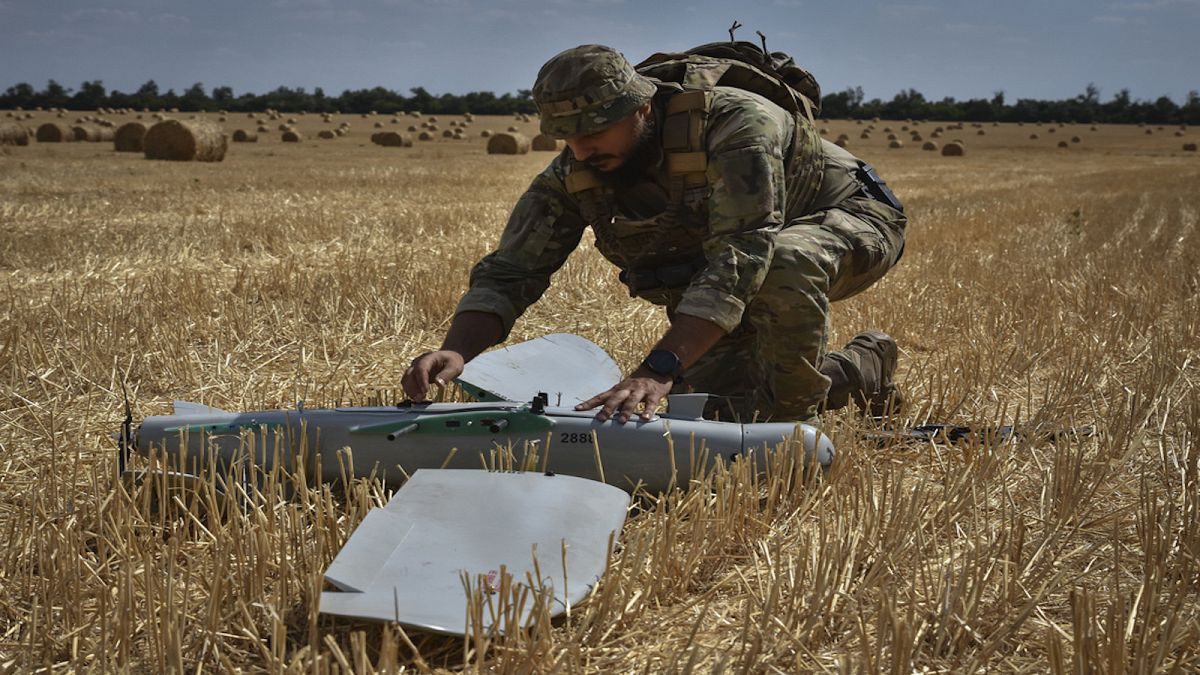California
Southern California Commercial Real Estate Faces Uncertainty: Forum

On a jealousy-inducing, sunny fall day in Beverly Hills, dark shadows were nonetheless cast on the current development environment in Los Angeles and Southern California as a whole.
At Commercial Observer’s “West Coast CRE Investment Forum” Oct. 30 at the SLS Beverly Hills Hotel, industry players painted a picture of limbo and uncertainty on the national stage, with Southern California’s high costs and regulatory environment making an already challenging situation much worse.
“Capital doesn’t like surprises,” said Glenn Sonnenberg, president and CEO of LaSalle Debt Investors, during a panel on finding financing in today’s volatile markets. “In SoCal, there’s a lot of surprises and a lack of stability.”
Many speakers said the protracted challenges hampering commercial real estate’s full recovery — including high interest rates, locked-up funding and financing, and difficulty kick-starting ground-up construction — have been made worse by Measure ULA. That 5 percent transfer tax on real estate deals worth at least $10 million, which voters passed in 2022, is supposed to fund a broad suite of efforts to fight homelessness and high housing costs.
Many forum speakers took shots at what they described as the red tape and regulatory risk wrought by Measure ULA. It’s already been underperforming in terms of revenue estimates due to low transaction volumes, and the legislation is squarely blamed for a significant cooling of construction.
“Nobody wants to build here,” said Michael Regan, managing director of investments at developer CIM Group, speaking as part of a panel about capitalizing on distressed opportunities. “ULA knocks off a bunch of your profit. Supply will be muted on a go-forward basis.”
While there were rays of sunshine, including continued demand for industrial product in the nation’s most important logistics hub, many of the day’s speakers echoed their frustration over recent political changes, including ULA, recent rent control measures and moratoriums, and a statewide measure asking firms to report their carbon emissions and climate risks. Pacific Urban Investors Managing Director Ash Baraghoush said that some of his “competitors have redlined L.A.” because of political discord over development policies.”
This backlash over referendums and local laws overlapped with existing market difficulties, especially the financing drought impacting so many developers and owners. Kyle Jeffers, CEO at Acore Capital, said that, until rates are fixed, “you’re sitting on a market that’s essentially frozen.” This was largely the accepted wisdom of fellow panelists Baraghoush and Caroline Wu of analytics firm Placer.ai, even if Concord Companies’ Samuel Landman sounded slightly more philosophical about future development.
“There are 40 million people here — people are going to keep coming,” said Landman, Concord’s chief investment officer, expressing long-term belief in Los Angeles and California. The panel was moderated by Shally Hu of Ariella Capital Group.
But more of the real estate pros in attendance were eager to voice concerns about their ability to get big projects completed to keep up with demand.
During a fireside chat with Don Peebles, founder and CEO at developer The Peebles Corporation, and Kofi Nartey, the CEO of GLOBL Real Estate and Development, Peebles said he believes things will get worse before they get better. Hiis firm’s $1.6 billion Angels Landing megaproject downtown has faced increased challenges due to the city regulatory regime.
During a morning session, “Financing Your Deal: Finding Capital in Volatile Markets,” participants sketched how the market has locked up: There’s a significant disparity and disconnect between public and private valuations, billions of dollars of capital is on the side, and there’s a shortage of funding for new construction.
During the panel, Jason Choulochas, managing director of originations of Bank OZK (OZK), said his firm aims to get $8 billion out the door this year. It’s a challenge to do that many deals in this market, he said, yet “never underestimate developers’ desire to develop.” With lending slowing way down, Choulochas said his firm has been able to pick up the slack.
For a number of quarters now, there have been predictions of a bounceback, though most panelists felt things won’t truly stabilize until later in 2024. They said it’s part of a multiyear process that’s led many to seek to set themselves up for success in terms of prepping a pipeline and waiting. Sonnennberg said once things stabilize, it “will be like someone spiked the punch bowl, and deals will get done.”
Also on the financing panel was Invesco Real Estate’s Teresa Zien, Ares Management’s Danielle Duenas, and Christine Kang of Clarion Partners. Daniel Liffmann of law firm Mayer Brown moderated.
That delay in deals also includes distressed assets. During an afternoon session, “Capitalizing on Distressed Opportunities: How Savvy Investors Are Positioning Opportunistic Capital,” panelists said the market was preparing, not executing, around distressed properties.
Jennifer Halvas, managing director of investor relations at investment and development firm Cityview, said her firm’s investors want Cityview to take a wait-and-see attitude and make plans to take advantage of the market. Lots of deals for rescue capital are being and will be made — trillions of dollars in loans will mature through 2026 — and lenders are slightly more flexible. This is especially true for deals on the cusp, since they don’t want to take on more assets right now. Michael Regan of CIM Group and Spencer Schlee of Canyon Partners Real Estate joined Halvas. Darwin Huang of law firm Kasowitz Benson Torres moderated.
Even industrial, which has shined for years now amid SoCal’s woes, isn’t all rosy. During the “Industrial Revolution” panel, it was clear that, while demand is still quite strong, with new development and needs along the Mexican border spurred by reshoring and the development of fresh light manufacturing, challenges lay ahead.
Roughly 900 million square feet of industrial is in Los Angeles, but just 9 million square feet is delivering in the next year, which will keep rents high and vacancies low. Tenants, hit hard by rising costs, have struggled, said Mason Waite, managing director of asset management for BM Capital Partners, who appeared on the panel with Greg Skaler of Elion Partners.
“They’re getting squeezed at all levels,” Waite added, “with all input costs going up.” But he said he sees significant upside, both because of massive federal investments from the infrastructure bill, the Inflation Reduction Act and the CHIPS and Science Act.
There were plenty of other bright spots amid a larger consensus about local and national challenges. Commercial Observer’s West Coast Impact Awards celebrated regional developments highlighting the great potential of pushing through the challenges and red tape.
Sandy Sigal, retail and tech titan of NewMark Merrill, won the West Coast Impact Award; Related Companies won for its Grand LA multi-use megadevelopment; Hillwood took home Deal of the Year for its $559 million, CBRE-brokered deal to turn an industrial park into the Speedway Commerce Center; Worthe won Studio Lease of the Year for the Frank Gehry-designed Second Century, an adaptive reuse of an old Warner Bros.’ lot; and Bank OZK took home the Dealmaker of the Year award.
During a closing speech, the Los Angeles Rams’ Chief Operating Officer Kevin Demoff explained how the football franchise helped create a massive new live-work-play district centered on the new SoFi stadium, and how a business-friendly climate in the city of Inglewood played a big role.
Keeping Angelenos in Los Angeles, and keeping development moving at a speed and scale to accommodate them will require effort from elected officials to repeal or rework regulations, such as California’s Environmental Quality Act. Such regulations stand in the way of development, according to participants at a late afternoon panel about affordable housing and multifamily development. Many said they’d left an excessively regulated L.A. proper behind, focusing instead on surrounding areas such as Ventura and Orange counties. Without more action, they said, L.A. would lose some of the spark that drew so many there.
In the panel “Making Southern California More Real Estate-Friendly Through Multifamily and Affordable Housing Development,” all the panelists — Joseph Soleiman of Vivo Investments, Jared Goldstein of Canfield Development, Wes LaBar of TruAmerica Multifamily and Henry Manoucheri of Universe Holdings — said that they were not building ground-up or buying in L.A. at the moment but instead were looking on the periphery. This is despite extremely good fundamentals in L.A. such as high rents and low vacancy.
“We need commitment from politicians to welcome businesses into the city,” said Schlee of Canyon Partners, a firm founded in L.A. that had recently opened a new office in Dallas. “It’s important to note that we’re competing against the entire country.”

California
Park Fire: California man sees home burn for second time
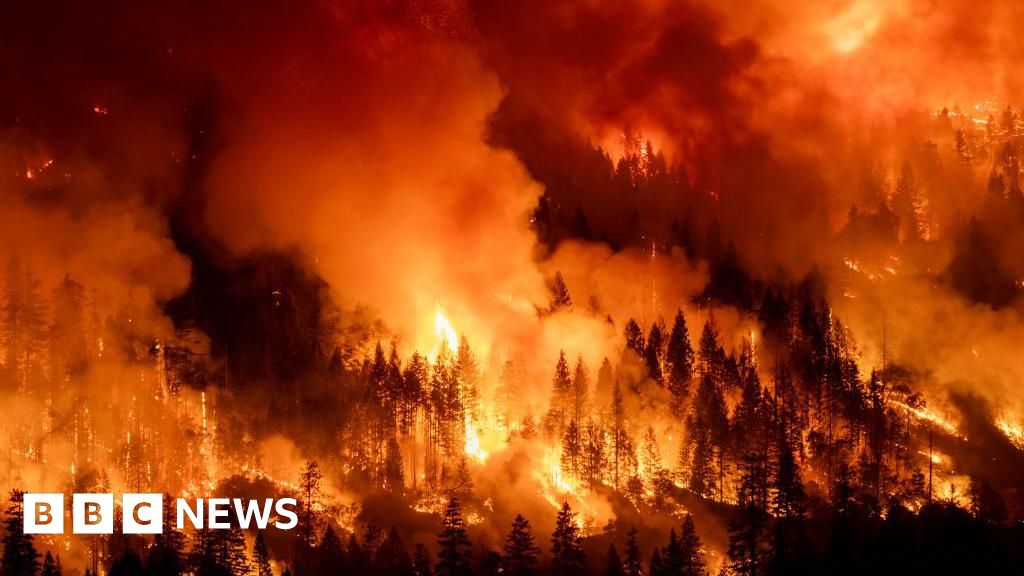
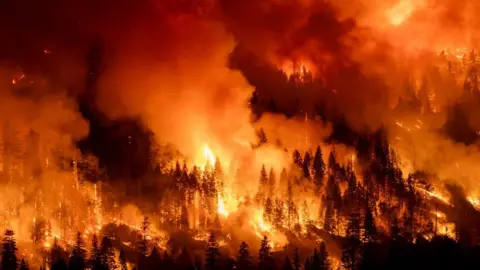 Getty Images
Getty ImagesRick Pero was working in southern Mexico when the evacuation alerts started going off on his phone.
A wildfire was threatening his California neighbourhood. Again.
Back home – roughly 2,800 miles (4,500km) away – a man at a popular swimming hole shoved a burning car down into a dry, grassy ravine. Almost instantly, the area ignited and those enjoying the summer day started to panic. The flames, about 15 miles (24km) from Mr Pero’s home, were spreading fast in the tinder dry brush.
“Uh oh, this is not looking good,” Mr Pero thought as he watched the blaze’s growth from his phone.
Within hours, the Park Fire had consumed more than 6,000 acres and residents in the area were forced to evacuate. With them, the suspected arsonist who police say blended into the worried crowd and fled the area.
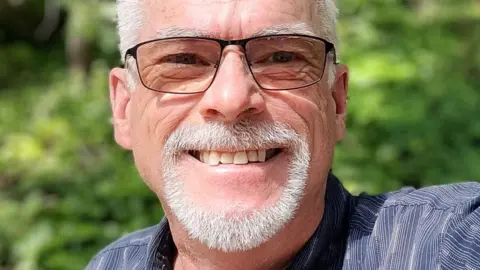
Mr Pero, glued to his phone, packed his bags. He told his cat sitter to get his two felines and leave before it was too late. He knew the danger after surviving the deadliest and most destructive wildfire in California’s history in 2018 – which razed the town of Paradise and took 85 lives. His home was incinerated.
Mr Pero rebuilt his life in Forest Ranch, another small community about nine miles (14km) north of Paradise. He thought he was safe – his new “silver lining” home had stunning views and was much more fire resistant. But once again, a fire tore through his home and everything inside of it – possibly also stealing one of his cats that couldn’t be lured out of the house.
The metal disfigured shells of two vehicles remain where his garage once stood. Piles of charred metal debris lay in piles. The foundations of the home aren’t even apparent anymore but some bricks from what appears to be a fireplace are stacked. The colourful sunset views over the wooded area behind his home now looks out on hundreds of scorched – and still smoking – pine trees.
“The big sadness is we have a very close-knit neighbourhood,” he said. “I’m again, so, so grateful that they were able to save all of my neighbours, almost all my neighbours, houses.”
Wildfires are becoming more intense and more frequent.
The Park Fire, which started 24 July in a park in Chico, grew to more than 71,000 acres in just 24 hours. It’s now the fourth largest wildfire in California history after tearing through more than 400,000 acres and like Paradise, it spread at a shockingly fast and hot pace.
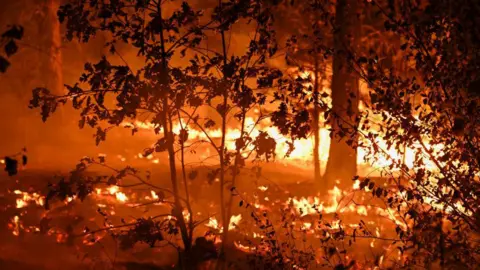 Getty Images
Getty ImagesAbout 12 hours after the blaze started, the person authorities say is responsible was arrested. Police say Ronnie Dean Stout II was spotted starting the fire and blending into the crowd as people rushed to flee. Witnesses said he acted erratically and may have been intoxicated.
Authorities found him at a nearby mobile home park and charged him with arson. He has not entered a plea but reportedly told authorities his burning car rolled down the 60-foot embankment and it was an accident. He fled the area afterwards because he was afraid, Butte County District Attorney Michael Ramsey said.
The blaze has consumed land in four counties, scorching an area larger than the size of greater Los Angeles or London. Although most of the land is uninhabited by humans, hundreds of homes have been lost in the blaze and experts worry it could take months before it’s fully extinguished.
The area is a frequent target of destructive wildfires. The region in northern California “has had four of the largest 10 fires” in the state’s history, Cal Fire Incident Commander Billy See said at a news conference
Eight of the 10 largest wildfires in California history have happened in the last five years. Scientists say the impacts from wildfires and other extreme weather events have worsened due to climate change. And undoubtedly, this new fire will reinvigorate debates about where and how we live and rebuild in an increasingly hot and dry Western United States.
Escape from Paradise
Last time he evacuated, in 2018, Mr Pero was home with his wife in Paradise. They had just 20 minutes to flee – but it was enough time to grab their photo albums, phones, computers, cars and cats.
That fire ripped through Paradise at a truly unprecedented speed and heat – catching everyone off guard with its ferocity. Of the 85 people who perished, many died in their cars, trying to escape on the rural town’s windy, mountain roads.
Paradise Police Sgt Rob Nichols was one of the many quick-thinking heroes that day. As fire engulfed the town, propane tanks exploded and power lines and burned-out cars blocked the road. His wife and young children got out safely, but Sgt Nichols stayed to help.
Along with firefighters and volunteers, they smashed the windows of an empty building that had a large parking lot – a barrier that could prevent the building from burning – and hustled about 200 people inside as they watched in horror as their beloved mountain town burned. Sgt Nichols lost everything he owned.
He still works in Paradise but he resettled with his family in Chico, about a mile from where the Park Fire ignited. Chico was where many of the Paradise evacuees headed in 2018 – many sleeping in tents around a Walmart or in camper vans until they could resettle elsewhere.
Sgt Nichols was on vacation – 135 miles (217km) away in Lake Siskiyou – when he started hearing news that a wildfire was threatening his home. Again.
“On our last evening up there, we couldn’t rest not knowing what was going on and how close it was to the home,” he said. “So we came home.”
Sgt Nichols didn’t anticipate how scary it would be for his children, ages 12 and 13, as they arrived home and saw flames taking over an area on the ridge above their neighbourhood.
“That was kind of a big trigger for them,” he said.
Fortunately, their house was spared. The wind sent the blaze in the opposite direction.
But it was close. He sometimes thinks about moving to a less fire prone area.
“My wife has a lot of family here,” he said, noting the ties that have kept them in the area. “And, you know, we lost seven homes. Her family lost seven homes in the Camp Fire. And so we don’t want to go too far.”
Paradise is likely safer now than most places, he argues, because there just isn’t much left to burn. He’d like to rebuild there, but building costs have skyrocketed and insurance is prohibitively expensive due to wildfires.
Now Sgt Nichols is patrolling around Chico – on loan from Paradise police – to help deter looters or opportunists who attempt to raid communities after an evacuation order.
Fire resistant
Mr Pero saw his Forest Ranch house as a paradise away from Paradise because of its natural beauty and how close it kept him and his wife to the community they’d grown to love.
He became serious, maybe obsessed, about fire safety and was in charge of his neighbourhood’s fire mitigation. He says it’s “ironic” his home burned. He had about 50 yards of cleared space behind his house, a barrier he hoped would stop any potential blaze from continuing toward his oasis.
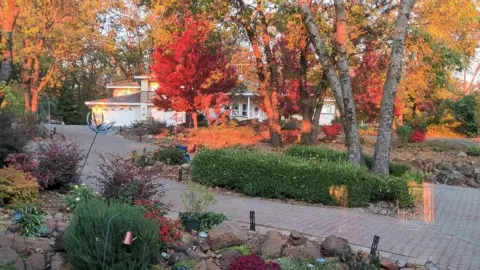
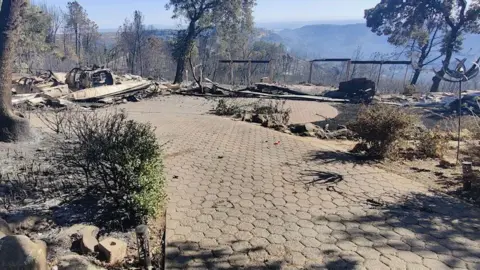
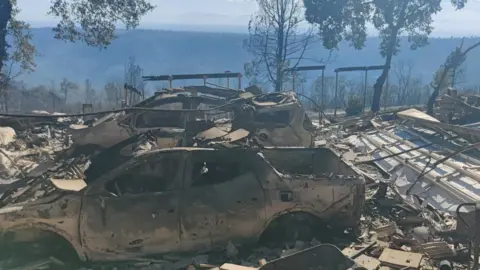
“It had 60,000-gallon water tanks. It also had fire hydrants on the street,” he said. “And the big part, it was also about a one-minute route to get evacuated out on Highway 32 versus nine hours in Paradise.”
Every year, they brought in hundreds of goats to clear brush, which can be like kindling for any fire, throughout the community. He urged his neighbours to make their homes fire safe by trimming trees and clearing brush.
He’s hoping his lost cat – a striped grey and black feline named CatMandu – made it out alive. Mr Pero has been leaving out food and searching for him around the wreckage.

But the charred remains of his home are still too toxic to walk around – he needs a special mask and suit to search for any sign of the cat or any belongings that survived the blaze.
“I tried to look from the edges,” he said. “Didn’t see anything.”
Three other homes on his street also burned to the ground. They were owned by Paradise fire survivors, he says.
He and his wife loved their time in Forest Ranch. But he doubts they will rebuild there. He says he doesn’t know if they can start over again in such a fire-prone area. They’re thinking maybe somewhere coastal – near water. Somewhere less dry. Somewhere safer.
He knows people who have relocated to the rain-prone state of Oregon and the often-rainy Ireland.
“We’re kind of wide open now.”
California
Firefighters continue battling massive wildfire in California ahead of thunderstorms, lightning

CHICO, Calif. — Firefighters made progress Saturday against California’s largest wildfire of the year ahead of expected thunderstorms that could unleash fire-starting lightning and erratic winds and erode progress made over the past week. Dry, hot conditions posed similar threats across the fire-stricken West.
“We’re not completely out of the woods yet, but we’re looking very, very good,” CalFire official Mark Brunton said in a video update Saturday. “This is moving at a very fast pace.”
Containment of the Park Fire, now California’s fourth-largest wildfire on record, is at 27% as of early Saturday. Brunton said the relatively milder weather the last few days allowed firefighters to build containment lines.
But hotter weather, fuels and terrain will continue posing challenges for the estimated 6,500 firefighters battling the fire, which has spread over 626 square miles (1,621 square kilometers) since allegedly being started by arson in a park in the Sierra Nevada foothills east of the Sacramento Valley city of Chico. For comparison, the city of Los Angeles covers about 503 square miles (1,302 square kilometers).
Suppression crews will also start removing damaged infrastructure in some areas Saturday to allow residents to return home.
The fire originated at low elevations, where it quickly burned through thick grass and oaks, destroying at least 567 structures and damaging 51 so far. As it has climbed higher, the vegetation has changed to a greater concentration of trees and brush, Cal Fire said.
The fire’s push northward has brought it toward the rugged lava rock landscape surrounding Lassen Volcanic National Park, which has been closed because of the threat.
“There’s a lot of really steep drainages in that area,” CalFire spokesperson Devin Terrill said. “It takes a lot more time to access those areas.”
After a brief respite, firefighters are now bracing for treacherous conditions of hot and dry weather, along with expected thunderstorms with potential thunder strikes and gusty winds.
The collapse of thunderstorm clouds can blow wind in any and all directions, said Jonathan Pangburn, a fire behavior analyst with Cal Fire. “Even if there’s not lightning per se, it is very much a safety-watch-out environment for our firefighters out there,” Pangburn said.
The Park Fire is among almost 100 large fires burning across the western U.S. Evacuation orders were in effect for 28 of the fires, according to the National Interagency Fire Center.
Three wildfires burned in Colorado on Friday near heavily populated areas north and south of Denver, with about 50 structures damaged or destroyed, thousands of people under evacuation orders and human remains found in a destroyed house earlier this week.
The Jefferson County Sheriff’s Office is investigating a blaze threatening hundreds of homes near the Colorado city of Littleton as arson.
Karlyn Tilley, a spokesperson for Jefferson County Sheriff’s Office, said the investigation is ongoing and they are using a dog specially trained to sniff out sources and causes of fires. Tilley said just because they suspect the fire was human-caused doesn’t mean it was intentional.
Firefighters were making good progress on the fire despite the steep, rocky terrain and blistering heat, and no houses had been burned, officials said.
The cause and origin of a fatal blaze west of the town of Lyons was being probed by the federal Bureau of Alcohol, Tobacco, Firearms and Explosives, with specially trained fire investigators from the agency helping local authorities, agency spokesperson Crystal McCoy said. The area blackened by that fire remained relatively unchanged after it burned five houses.
The largest of the Colorado fires, west of Loveland, grew to 14.9 square miles (38.5 square kilometers) after previously burning 49 homes and other structures. Its cause is under investigation.
Scientists say extreme wildfires are becoming more common and destructive in the U.S. West and other parts of the world as climate change warms the planet and droughts become more severe.
California
‘I’ve never had an identity crisis’: Kamala Harris and the power of mixed-race California
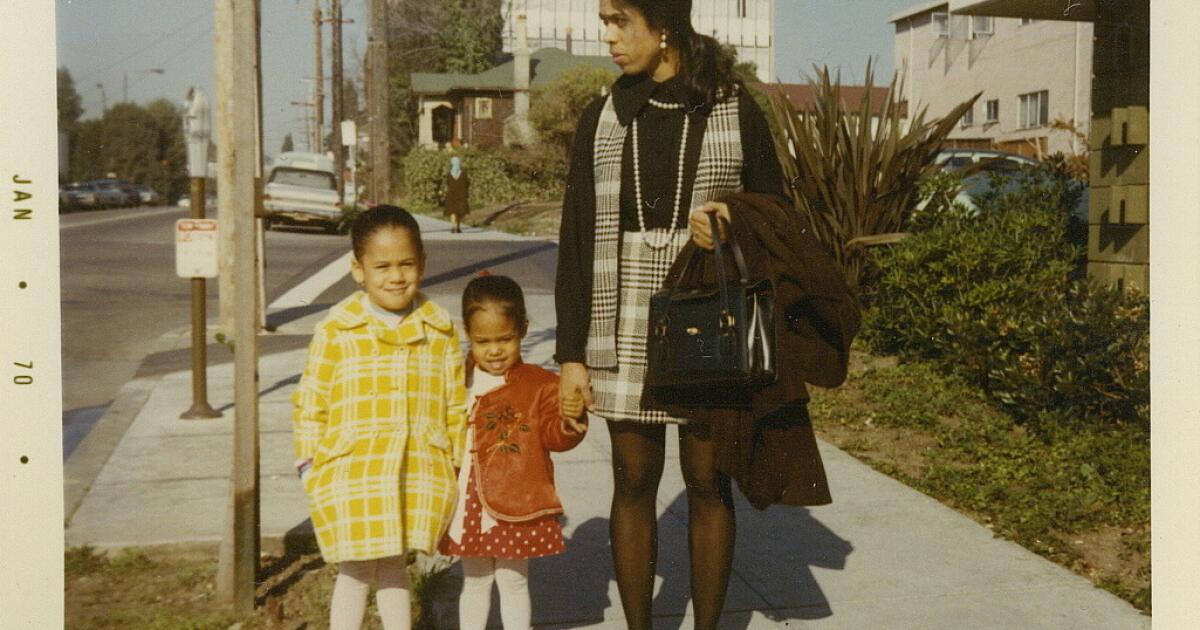
Hi and welcome to the L.A. Times Politics newsletter. I’m Shelby Grad, deputy managing editor for news, filling in for David Lauter today.
A generational shift
Thirty years ago, the Los Angeles Times polled residents of Orange County about their attitudes on interracial dating and romantic relationships. The poll found young people were highly supportive, with nearly 60% of those ages 18 to 34 saying they had dated someone from another racial or ethnic group.
Orange County was just beginning to shed its image as a conservative white bastion, and the survey underscored big divides between the older generation and the younger.
“My boyfriend is Latino,” a white Fullerton bank teller told the paper. “I haven’t run up against any resistance from my parents, but my grandparents don’t like it.”
I was a young reporter in the newsroom when the poll came out, and I remember being impressed with the findings. And that sentiment came to represent the way a new generation of Californians defined their experience — with the belief that the mixing of races is not only our strength, but our secret weapon.
Today, nearly 16% of Californians identify as being of two or more races. And that includes the woman who is poised to be the Democratic presidential nominee.
A 78-year-old man’s recent comments questioning Kamala Harris’ multiracial identity could easily be written off as the outdated notion of earlier generations. But it was Donald Trump, and his words had a political purpose.
Trump falsely claimed that Harris “was Indian all the way and then all of a sudden she made a turn, she became a Black person.”
The news cycle since his comments Wednesday during a session with three reporters at the annual convention of the National Assn. of Black Journalists has thoroughly discredited and dissected his words.
A California childhood
But perhaps it is more instructive to hear in Harris’ own words what it was like to grow up as a mixed-race Californian, born in Oakland to an Indian mother and a Jamaican father.
“My Indian mother knew she was raising two Black daughters,” Harris told The Times’ Michael Finnegan in 2019. “But that’s not to the exclusion of who I am in terms of my Indian heritage.
“I grew up going to a Black Baptist church and a Hindu temple,” she explained.
She described a rich childhood of family visits to India and of Aretha Franklin’s gospel rendition of “Young, Gifted and Black“ as a soundtrack of her youth in a Black middle-class neighborhood in the flats of Berkeley.
Explaining identity to others
Harris went even deeper during an “Asian Enough” podcast interview with Frank Shyong and Jen Yamada in 2020. She talked about the challenges of explaining your identity to those unfamiliar with it.
“You’re required to explain things about yourself that otherwise you may not be required to explain. And that can be challenging for a number of reasons, including because you know, at that moment, you might prefer that the interview was about your plan for the economy,” she said with a laugh. “But you’re trying to help people figure out who you are even though you’re really comfortable in your own skin.”
Harris said she understood the need for voters — especially those never exposed to the diversity of her California — to get to know her.
“The challenge becomes, then, when you don’t fit in someone’s preconceived notion of who is president of the United States, because their only reference point is who has been president of the United States, and not one of those people looks like you, it presents a challenge,” she told Shyong and Yamada.
But Harris made a point of saying those struggles were never hers.
“I’ve never had an identity crisis,” she said, adding, “The frustration I have is that people think I should have gone through such a crisis and need to explain it.”
And she credited growing up in the Bay Area as one reason for that clear sense of identity : “There was such a cultural mix of people in the community. … It just wasn’t an issue for me.”
What else you should be reading
The must-read: Why California’s surge in immigration is lifting our economy
The exodus: Chevron, the oil giant born in California 145 years ago, is moving to Texas
The L.A. Times special: Tired of text spam from political fundraisers? Here’s what to do
Until next time,
Shelby Grad
—
Was this newsletter forwarded to you? Sign up here to get it in your inbox.
-

 Mississippi4 days ago
Mississippi4 days agoMSU, Mississippi Academy of Sciences host summer symposium, USDA’s Tucker honored with Presidential Award
-

 World1 week ago
World1 week agoTyphoon Gaemi barrels towards China’s Fujian after sinking ship off Taiwan
-

 Politics7 days ago
Politics7 days agoRepublicans say Schumer must act on voter proof of citizenship bill if Democrat 'really cares about democracy'
-
World6 days ago
More right wing with fewer women – a new Parliament compendium
-

 News1 week ago
News1 week agoVideo: Kamala Harris May Bring Out Trump’s Harshest Instincts
-

 News1 week ago
News1 week agoWho Can Achieve the American Dream? Race Matters Less Than It Used To.
-

 Politics1 week ago
Politics1 week agoTrump announces to crowd he 'just took off the last bandage' at faith event after assassination attempt
-

 World7 days ago
World7 days agoIsrael says Hezbollah crossed ‘red line’, strikes deep inside Lebanon
